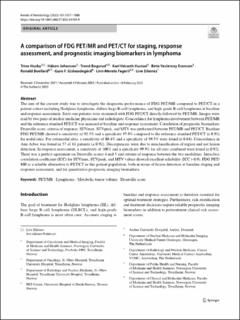| dc.contributor.author | Husby, Trine | |
| dc.contributor.author | Johansen, Håkon | |
| dc.contributor.author | Bogsrud, Trond | |
| dc.contributor.author | Hustad, Kari Vekseth | |
| dc.contributor.author | Evensen, Birte Veslemøy | |
| dc.contributor.author | Boellard, Ronald | |
| dc.contributor.author | Giskeødegård, Guro F. | |
| dc.contributor.author | Fagerli, Unn-Merete | |
| dc.contributor.author | Eikenes, Live | |
| dc.date.accessioned | 2023-02-10T10:30:02Z | |
| dc.date.available | 2023-02-10T10:30:02Z | |
| dc.date.created | 2022-04-29T12:51:03Z | |
| dc.date.issued | 2022 | |
| dc.identifier.citation | Annals of Hematology. 2022, 101 (5), 1077-1088. | en_US |
| dc.identifier.issn | 0939-5555 | |
| dc.identifier.uri | https://hdl.handle.net/11250/3049995 | |
| dc.description.abstract | The aim of the current study was to investigate the diagnostic performance of FDG PET/MR compared to PET/CT in a patient cohort including Hodgkins lymphoma, diffuse large B-cell lymphoma, and high-grade B-cell lymphoma at baseline and response assessment. Sixty-one patients were examined with FDG PET/CT directly followed by PET/MR. Images were read by two pairs of nuclear medicine physicians and radiologists. Concordance for lymphoma involvement between PET/MR and the reference standard PET/CT was assessed at baseline and response assessment. Correlation of prognostic biomarkers Deauville score, criteria of response, SUVmax, SUVpeak, and MTV was performed between PET/MR and PET/CT. Baseline FDG PET/MR showed a sensitivity of 92.5% and a specificity 97.9% compared to the reference standard PET/CT (κ 0.91) for nodal sites. For extranodal sites, a sensitivity of 80.4% and a specificity of 99.5% were found (κ 0.84). Concordance in Ann Arbor was found in 57 of 61 patients (κ 0.92). Discrepancies were due to misclassification of region and not lesion detection. In response assessment, a sensitivity of 100% and a specificity 99.9% for all sites combined were found (κ 0.92). There was a perfect agreement on Deauville scores 4 and 5 and criteria of response between the two modalities. Intraclass correlation coefficient (ICC) for SUVmax, SUVpeak, and MTV values showed excellent reliability (ICC > 0.9). FDG PET/MR is a reliable alternative to PET/CT in this patient population, both in terms of lesion detection at baseline staging and response assessment, and for quantitative prognostic imaging biomarkers. | en_US |
| dc.language.iso | eng | en_US |
| dc.publisher | Springer | en_US |
| dc.rights | Navngivelse 4.0 Internasjonal | * |
| dc.rights.uri | http://creativecommons.org/licenses/by/4.0/deed.no | * |
| dc.title | A comparison of FDG PET/MR and PET/CT for staging, response assessment, and prognostic imaging biomarkers in lymphoma | en_US |
| dc.title.alternative | A comparison of FDG PET/MR and PET/CT for staging, response assessment, and prognostic imaging biomarkers in lymphoma | en_US |
| dc.type | Peer reviewed | en_US |
| dc.type | Journal article | en_US |
| dc.description.version | publishedVersion | en_US |
| dc.source.pagenumber | 1077-1088 | en_US |
| dc.source.volume | 101 | en_US |
| dc.source.journal | Annals of Hematology | en_US |
| dc.source.issue | 5 | en_US |
| dc.identifier.doi | 10.1007/s00277-022-04789-9 | |
| dc.identifier.cristin | 2020124 | |
| cristin.ispublished | true | |
| cristin.fulltext | original | |
| cristin.qualitycode | 1 | |

